The AMD Ryzen Threadripper 1950X and 1920X Review: CPUs on Steroids
by Ian Cutress on August 10, 2017 9:00 AM ESTRocket League
Hilariously simple pick-up-and-play games are great fun. I'm a massive fan of the Katamari franchise for that reason — passing start on a controller and rolling around, picking up things to get bigger, is extremely simple. Until we get a PC version of Katamari that I can benchmark, we'll focus on Rocket League.
Rocket League combines the elements of pick-up-and-play, allowing users to jump into a game with other people (or bots) to play football with cars with zero rules. The title is built on Unreal Engine 3, which is somewhat old at this point, but it allows users to run the game on super-low-end systems while still taxing the big ones. Since the release in 2015, it has sold over 5 million copies and seems to be a fixture at LANs and game shows. Users who train get very serious, playing in teams and leagues with very few settings to configure, and everyone is on the same level. Rocket League is quickly becoming one of the favored titles for e-sports tournaments, especially when e-sports contests can be viewed directly from the game interface.
Based on these factors, plus the fact that it is an extremely fun title to load and play, we set out to find the best way to benchmark it. Unfortunately for the most part automatic benchmark modes for games are few and far between. Partly because of this, but also on the basis that it is built on the Unreal 3 engine, Rocket League does not have a benchmark mode. In this case, we have to develop a consistent run and record the frame rate.
Read our initial analysis on our Rocket League benchmark on low-end graphics here.
With Rocket League, there is no benchmark mode, so we have to perform a series of automated actions, similar to a racing game having a fixed number of laps. We take the following approach: Using Fraps to record the time taken to show each frame (and the overall frame rates), we use an automation tool to set up a consistent 4v4 bot match on easy, with the system applying a series of inputs throughout the run, such as switching camera angles and driving around.
It turns out that this method is nicely indicative of a real bot match, driving up walls, boosting and even putting in the odd assist, save and/or goal, as weird as that sounds for an automated set of commands. To maintain consistency, the commands we apply are not random but time-fixed, and we also keep the map the same (Aquadome, known to be a tough map for GPUs due to water/transparency) and the car customization constant. We start recording just after a match starts, and record for 4 minutes of game time (think 5 laps of a DIRT: Rally benchmark), with average frame rates, 99th percentile and frame times all provided.
The graphics settings for Rocket League come in four broad, generic settings: Low, Medium, High and High FXAA. There are advanced settings in place for shadows and details; however, for these tests, we keep to the generic settings. For both 1920x1080 and 4K resolutions, we test at the High preset with an unlimited frame cap.
All of our benchmark results can also be found in our benchmark engine, Bench.
MSI GTX 1080 Gaming 8G Performance
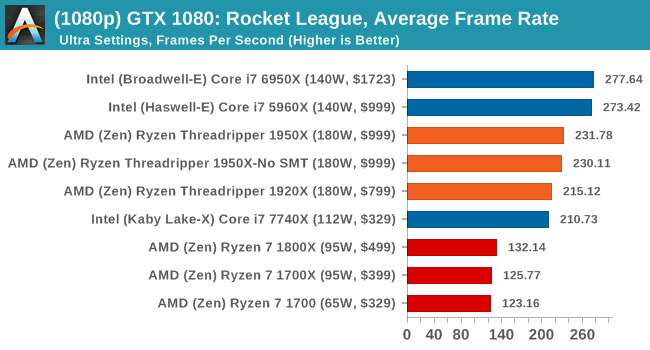
1080p

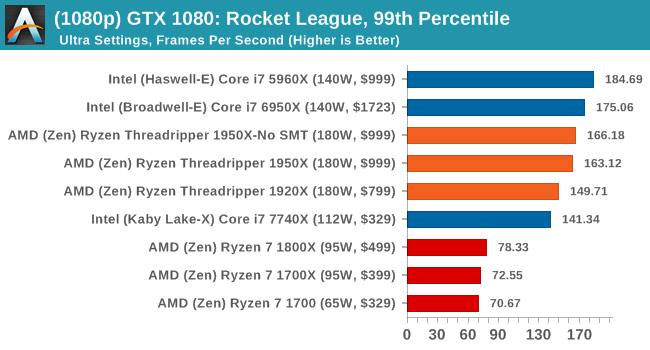
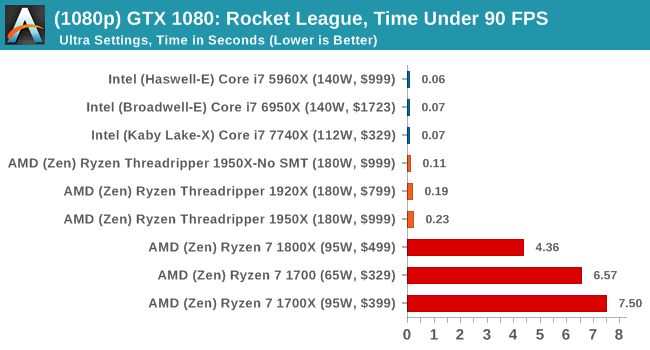
4K

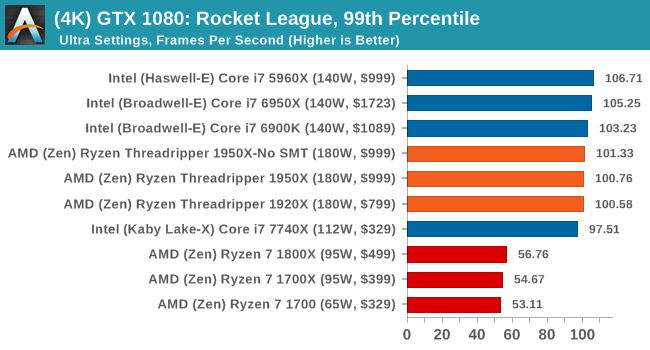
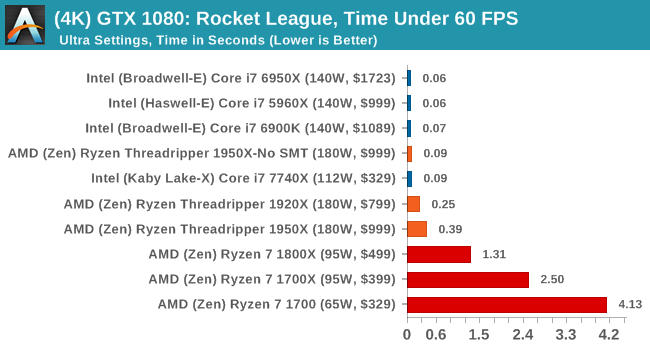
ASUS GTX 1060 Strix 6G Performance
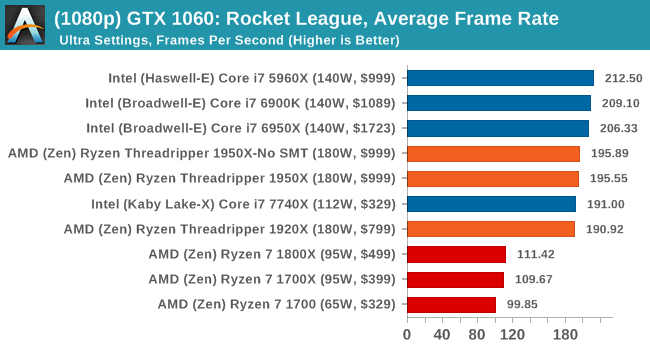
1080p

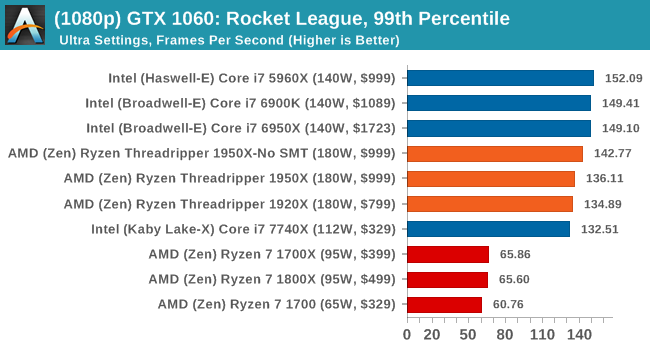
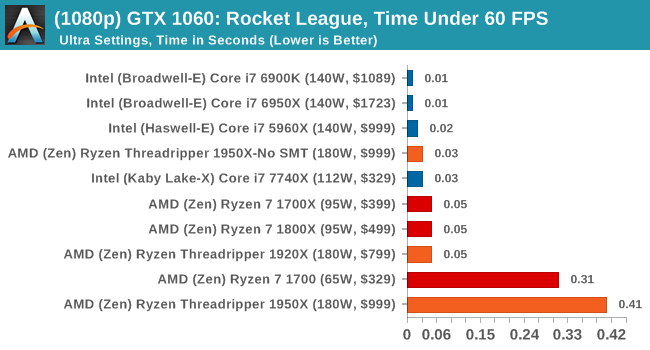
4K
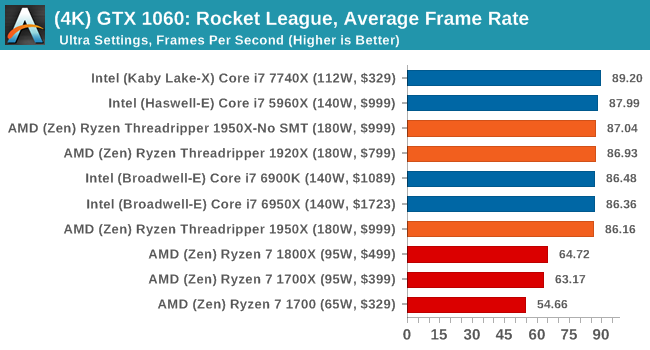
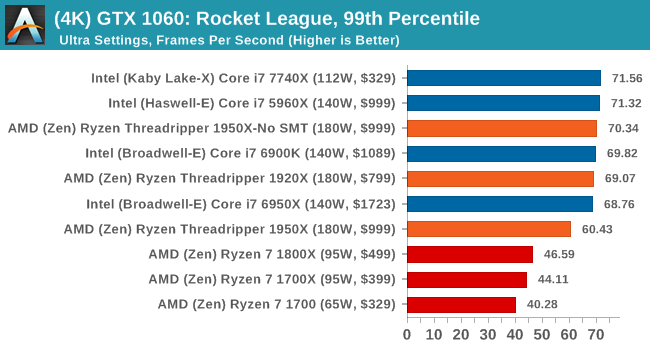
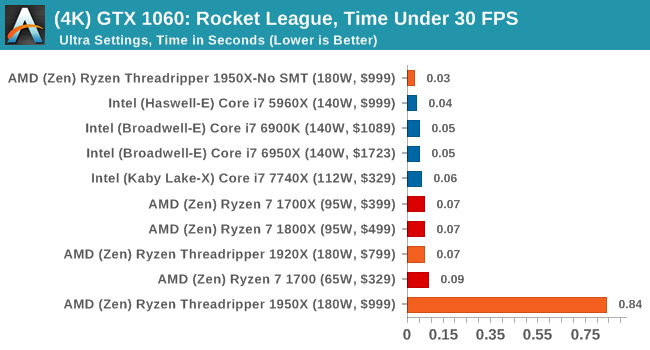
Sapphire Nitro R9 Fury 4G Performance
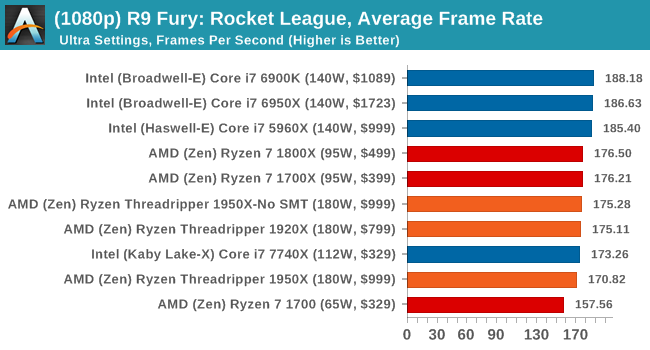
1080p

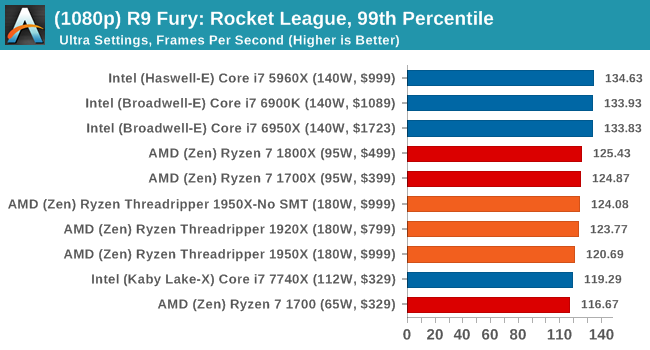
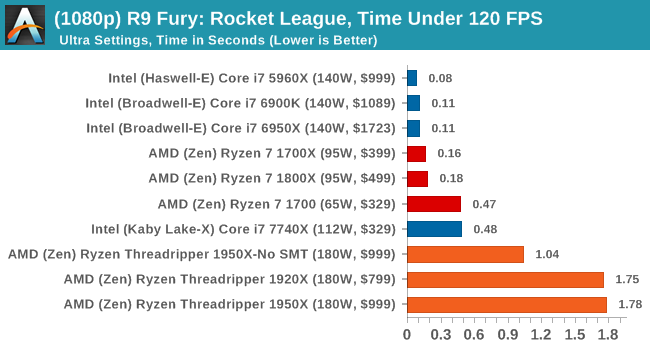
4K
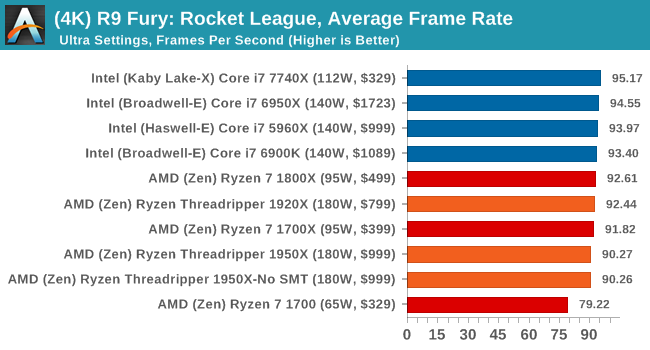
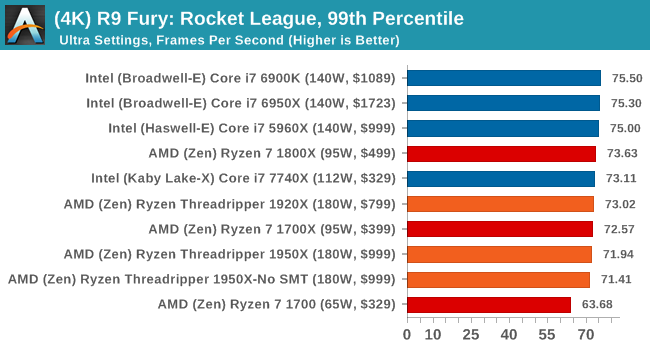

Sapphire Nitro RX 480 8G Performance
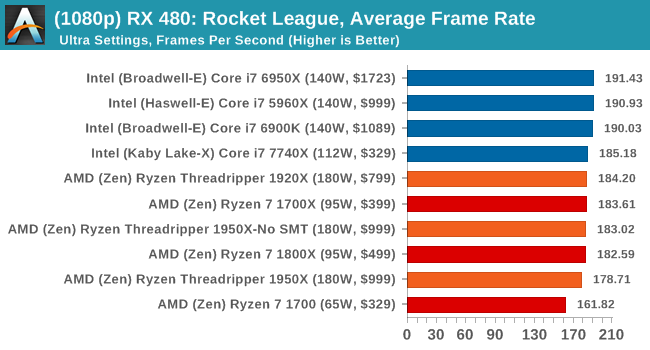
1080p

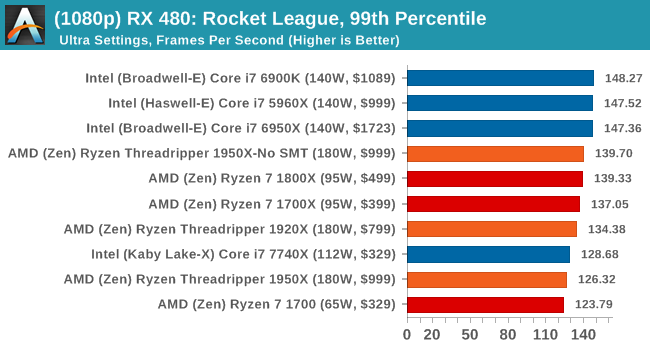
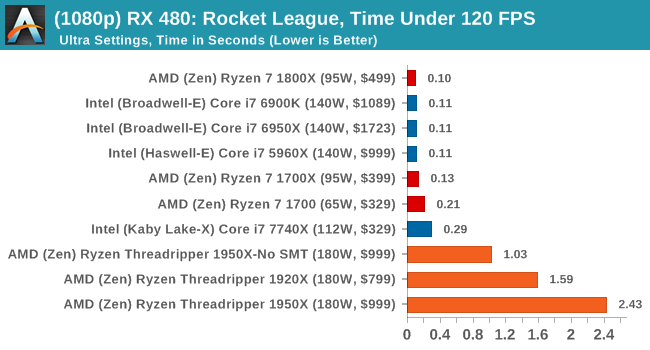
4K
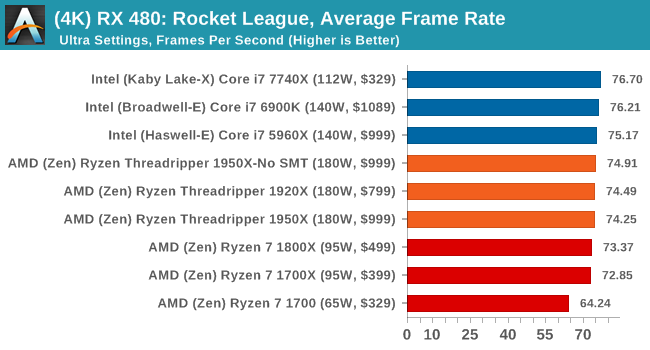
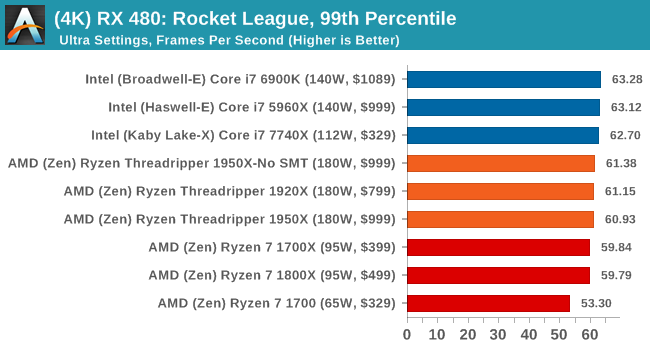
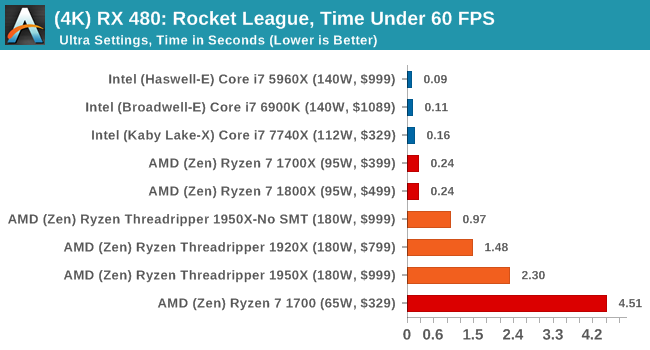
With Ryzen, we encounted some odd performance issues when using NVIDIA-based video cards that caused those cards to significantly underperform. However equally strangely, the issues we have with Ryzen on Rocket League with NVIDIA GPUs seem to almost vanish when using Threadripper. Again, still no easy wins here as Intel seems to take Rocket League in its stride, but SMT-off mode still helps the 1950X. The Time Under graphs give some cause for concern, with the 1950X consistently being at the bottom of that graph.


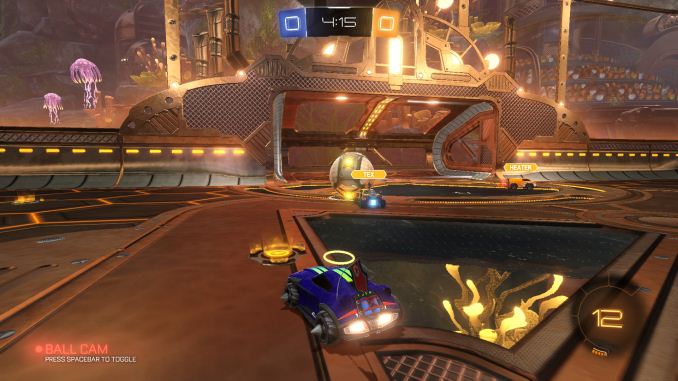
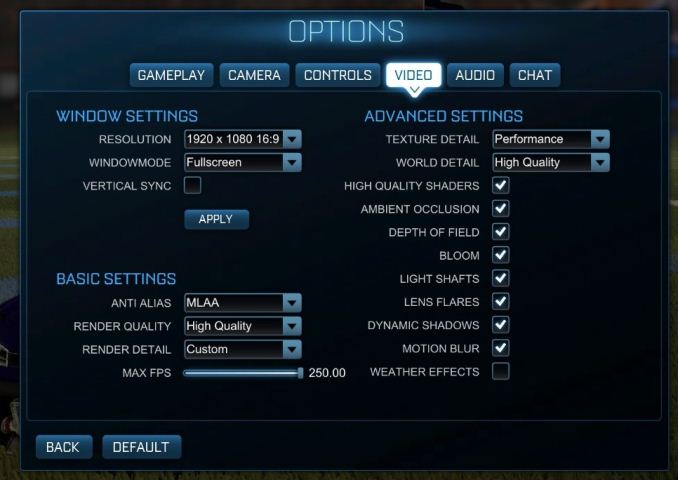








347 Comments
View All Comments
Ian Cutress - Thursday, August 10, 2017 - link
We didn't post gaming performance for Ryzen at launch either, for similar reasons.bongey - Thursday, August 10, 2017 - link
Stop lying , you commented on gaming performance in your conclusion, without even benchmarking it in gaming.That is much worse.
Adul - Thursday, August 10, 2017 - link
How is that lying? They did not post gaming benchmarks. That is what he said.What was mention in conclusion was not part of his statement.Integr8d - Thursday, August 10, 2017 - link
It's called lying by omission...James S - Friday, August 11, 2017 - link
Ian did not lie even by omission. They clearly stated in the Ryzen conclusion and clearly stated in the Skylake-x conclusion why they didn't test gaming.“You can please some of the people all of the time, you can please all of the people some of the time, but you can't please all of the people all of the time”
just4U - Saturday, August 12, 2017 - link
I think it's pretty ignorant of someone to state that Ian is lying in his own comments about articles he has written....alysdexia - Thursday, April 18, 2019 - link
Omission isn't lyging; it's self-censorship.Gothmoth - Thursday, August 10, 2017 - link
intel pays good money for advertising at anandtech....Nfarce - Thursday, August 10, 2017 - link
Listen to you fanyboy crybabies. Tom's and Guru3D did gaming benches too. Go find a Reddit AMD fanboy forum that will give a 100% glowing review of your precious Threadsnapper. You won't find a single credible tech site out there doing it. It's called impartiality. Oh and one more thing ladies: you all are aware that AMD sent the major tech review sites the EXACT same hardware kit for review, right?tuxRoller - Thursday, August 10, 2017 - link
ThreadSNAPPER? If this was intentional, I assume it's meant to be derogatory, but I'm not sure what it is meant to imply.